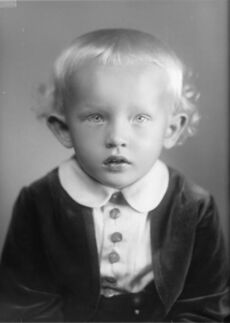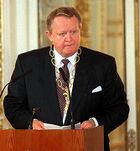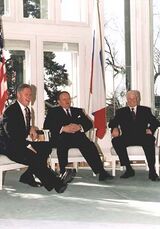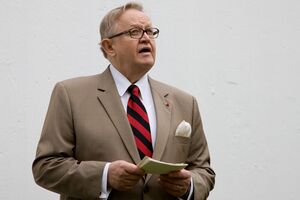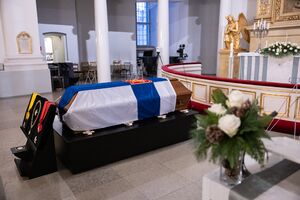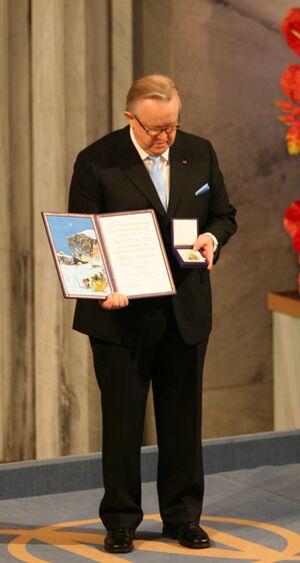مارتي آتيساري
مارتي آتيساري | |
|---|---|
Martti Ahtisaari | |
 مارتي آتيساري في هلسنكي 2012. | |
| رئيس فنلندا العاشر | |
| في المنصب 1 مارس 1994 – 1 مارس 2000 | |
| سبقه | Mauno Koivisto |
| خلـَفه | تاريا هالونن |
| سفير فنلندا في تنزانيا، زامبيا, الصومال وموزمبيق | |
| في المنصب 1973–1977 | |
| سبقه | Seppo Pietinen |
| خلـَفه | Richard Müller |
| تفاصيل شخصية | |
| وُلِد | 23 يونيو 1937 Viipuri, فنلندا (now Vyborg, روسيا) |
| توفي | 16 أكتوبر 2023 (aged 86) Helsinki, Finland |
| القومية | |
| الحزب | الحزب الديموقراطي الإجتماعي |
| الزوج | |
| الأنجال | ماركو |
| المدرسة الأم | جامعة أولو |
| الجوائز | جائزة نوبل للسلام (2008) |
| التوقيع | |
| الخدمة العسكرية | |
| الفرع/الخدمة | الجيش الفنلندي |
| الرتبة | Captain |
مارتي أويڤا كالڤي آتيساري ( Martti Oiva Kalevi Ahtisaari ؛ [ˈmɑrt:i ˈoivɑ ˈkɑleʋi ˈɑhtisɑ:ri] (و. 23 يونيو 1937 - 16 أكتوبر 2023)، هو رئيس فنلندا العاشر في الفترة (1994-2000), وفائز بجائزة نوبل للسلام وهو دبلوماسي ووسيط للأمم المتحدة، اشتهر بجهوده في عمليات السلام الدولي.
Ahtisaari was a United Nations special envoy for Kosovo, charged with organizing the Kosovo status process negotiations. These negotiations aimed to resolve a long-running dispute in Kosovo, which later declared its independence عن صربيا في 2008. وفي أكتوبر 2008, he was awarded the Nobel Peace Prize "for his important efforts, on several continents and over more than three decades, to resolve international conflicts".[1] The Nobel statement said that Ahtisaari had played a prominent role in resolving serious and long-lasting conflicts, including ones in Namibia, Aceh (Indonesia),[2] Kosovo and Serbia, and Iraq.[3]
. . . . . . . . . . . . . . . . . . . . . . . . . . . . . . . . . . . . . . . . . . . . . . . . . . . . . . . . . . . . . . . . . . . . . . . . . . . . . . . . . . . . . . . . . . . . . . . . . . . . . . . . . . . . . . . . . . . . . . . . . . . . . . . . . . . . . . . . . . . . . . . . . . . . . . . . . . . . . . . . . . . . . . . .
شبابه وعمله المبكر
Martti Ahtisaari was born in Viipuri, Finland (now Vyborg, Russia) on 23 June 1937.[4] His father, Oiva Ahtisaari, whose grandfather Julius Marenius Adolfsen had emigrated with his parents to Kotka, Finland in 1872 from Tistedalen in Southern Norway,[5] took Finnish citizenship in 1929 and Finnicized his surname from Adolfsen in 1935.[6] Oiva was working as a NCO in the supply troops in Vyborg when Martti was born.[6]
The Continuation War (World War II) took Oiva Ahtisaari to the front as an non-commissioned officer army mechanic, while Martti's mother, Tyyne, moved to Kuopio with her son to escape immediate danger from the war in 1940.[7][6] Kuopio was where Ahtisaari spent most of his childhood,[8] eventually attending Kuopion Lyseo high school.[6]
In 1952, Martti Ahtisaari moved to Oulu with his family.[6] There he continued his education in high school, graduating in 1956.[8] He also joined the local YMCA.[6] After completing his military service (Ahtisaari held the rank of captain in the Finnish Army Reserve),[9] he began to study at Oulu teachers' college, attending the two-year course which enabled him to qualify as a primary-school teacher in 1959.[6]
In the summer of 1960, Ahtisaari signed the contract for the position of director of the Swedish Agency for International Development physical education boarding school in Karachi, Pakistan, after interviewing in Sweden and hearing about the offer announced by the YMCA in April of that year.[6][4] There, he also trained as a teacher.[6]
He returned to Finland in 1963 and began his studies in the Helsinki School of Economics and soon became the Executive Director of the Helsinki International Student Club and Student International Aid, where he made friends with Namibian Nickey Iyambo.[6] He also joined the international students' organisation AIESEC.[10] In 1965, he joined the Ministry for Foreign Affairs[4] in its Bureau for International Development Aid, to set up the International Development Assistance Office together with Jaakko Iloniemi, which was a pioneering office, as the Finnish presence in international cooperation in the Third World was non-existent.[11] Ahtisaari remained in that office until 1972, where he served from 1971 as assistant to the director, a position he combined with his presence on the Government's Advisory Committee for Trade and Industry Affairs of Developing Countries.[12]
الدبلوماسية
In the Namibian independence transition
Ahtisaari began his diplomatic career in 1973 when he became Finland's Ambassador to Tanzania, Zambia, Somalia and Mozambique, an office he held until 1977.[12][13][6] This new mission allowed him to get closer to East African affairs, monitoring from Dar es Salaam the independence process of Namibia and maintaining close contacts with South West Africa People's Organisation (SWAPO).[6] In 1977 he was recalled by the United Nations to succeed Seán MacBride as United Nations Commissioner for Namibia, a post he held until 1981, and as representative of Secretary-General Kurt Waldheim from 1978.[4][12]
Following the death of a later UN Commissioner for Namibia, Bernt Carlsson, on Pan Am Flight 103 on 21 December 1988 – on the eve of the signing of the Tripartite Accord at UN Headquarters – Ahtisaari was sent to Namibia in April 1989 as the UN Special Representative to head the United Nations Transition Assistance Group (UNTAG).[12] Because of the illegal incursion of SWAPO troops from Angola, the South African appointed Administrator-General (AG), Louis Pienaar, sought Ahtisaari's agreement to the deployment of SADF troops to stabilize the situation. Ahtisaari took advice from British prime minister Margaret Thatcher, who was visiting the region at the time, and approved the SADF deployment. A period of intense fighting ensued when at least 375 SWAPO insurgents were killed.[14] In July 1989, Glenys Kinnock and Tessa Blackstone of the British Council of Churches visited Namibia and reported: "There is a widespread feeling that too many concessions were made to South African personnel and preferences and that Martti Ahtisaari was not forceful enough in his dealings with the South Africans."[15]
Perhaps because of his reluctance to authorise this SADF deployment, Ahtisaari was alleged to have been targeted by the South African Civil Cooperation Bureau (CCB). According to a hearing in September 2000 of the South African Truth and Reconciliation Commission, two CCB operatives (Kobus le Roux and Ferdinand Barnard) were tasked not to kill Ahtisaari, but to give him "a good hiding". To carry out the assault, Barnard had planned to use the grip handle of a metal saw as a knuckleduster. In the event, Ahtisaari did not attend the meeting at the Keetmanshoop Hotel, where Le Roux and Barnard lay in wait for him, and thus Ahtisaari escaped injury.[16]
After the independence elections of 1989, Ahtisaari and his wife were made honorary Namibian citizens in 1992.[6] South Africa gave him the O R Tambo award for "his outstanding achievement as a diplomat and commitment to the cause of freedom in Africa and peace in the world".[17]
Ahtisaari served as UN undersecretary-general for administration and management from 1987 to 1991 causing mixed feelings inside the organisation during an internal investigation of massive fraud. When Ahtisaari revealed in 1990 that he had secretly lengthened the grace period allowing UN officials to return misappropriated taxpayer money from the original three months to three years, the investigators were furious. The 340 officials found guilty of fraud were able to return money even after their crime had been proven. The harshest punishment was the firing of twenty corrupt officials.[18][19][20][6]
Other roles
On 31 July 1991, he was appointed Secretary of State at the Ministry for Foreign Affairs of Finland in the Esko Aho's government.[6][12] After the Gulf War, Ahtisaari headed a team tasked with reporting to the UN on changes in the situation and humanitarian needs.[6][12] The report did not meet these expectations and was believed to have eroded American support for Ahtisaari's candidacy for the UN Secretary-General.[6]
Between 1992 and 1993, Ahtisaari chaired the UN Conference on Yugoslavia's Working Group on Bosnia and Herzegovina and became the special assistant to Cyrus Vance, the Special Envoy of the Secretary-General of the United Nations for Croatia.[12][6]
رئيس فنلندا
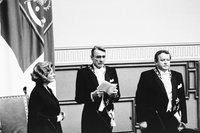
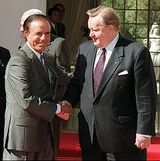
Finland's ongoing recession caused established political figures to lose public support, and the presidential elections were now direct instead of being conducted through an electoral college.[21][6][12] The Social Democratic Party of Finland's candidate to succeed Mauno Koivisto as President of Finland was decided in a primary between Ahtisaari and former Prime Minister and diplomat Kalevi Sorsa. Ahtisaari led in the polls against Sorsa, who was already a popular and experienced politician, and won the primaries on 16 May 1993 with 61% of the votes.[12][6]
After the primaries, Ahtisaari returned to his work in Geneva, and did not start his presidential campaign until the end of October.[6] Ahtisaari narrowly won over his second round opponent, Elisabeth Rehn of the Swedish People's Party.[12] During the campaign, there were rumours spread by some political opponents of Ahtisaari that he had a drinking problem or that he had knowingly accepted a double salary from the Finnish Foreign Ministry and from the United Nations while trying to negotiate an end to the Bosnian War. Ahtisaari denied both allegations and no firm proof of them has emerged. During the three-week campaign between the two rounds of presidential elections, Ahtisaari was praised by his supporters for being more compassionate towards the many unemployed Finns than Rehn, who as Defence Minister had to officially support the Aho government's strict economic policies. A minor controversy arose during a town hall-style presidential debate in Lappeenranta, southeastern Finland, when an apparently born-again Christian woman in the audience asked Rehn what her relationship with Jesus was. Rehn replied that she had personally no proof that Jesus had been a historical person. Ahtisaari ducked a precise answer by stating that he trusted the Lutheran confession even on this issue.[22][23][24] He was sworn in on 1 March 1994.[12]
His term as president began with a schism within the Centre Party government led by prime minister Esko Aho, who did not approve of Ahtisaari's being actively involved in foreign policy. There was also some controversy over Ahtisaari's speaking out on domestic issues such as unemployment. He travelled extensively in Finland and abroad, and was nicknamed "Matka-Mara" ("Travel-Mara", Mara being a common diminutive form of Martti). His monthly travels throughout the country and his meetings with ordinary citizens (the so-called maakuntamatkat or "provincial trips") nonetheless greatly enhanced his political popularity. Ahtisaari kept his campaign promise to visit one Finnish historical province every month during his presidency. He also donated some thousands of Finnish marks per month to the unemployed people's organisations, and a few thousand Finnish marks to the Christian social organisation of the late lay preacher and social worker Veikko Hursti.[25][26]
Ahtisaari favoured pluralism and religious tolerance publicly. Privately, he and his wife practised their Christian faith. Contrary to some of his predecessors and his successor as the Finnish President, Ahtisaari ended all of his New Year's speeches by wishing the Finnish people God's blessing.[27]
In January 1998 Ahtisaari was criticized by some NGOs, politicians and notable cultural figures because he awarded Commander of the Order of the Lion of Finland to the Forest Minister of Indonesia and to the main owner of the Indonesian RGM Company, a parent company of the April Company. The April Company was criticized by non-governmental organisations for destroying rain forests, and Indonesia itself was criticized heavily for human rights violations, especially in East Timor. Ahtisaari's party chairman Erkki Tuomioja said that giving medals was questionable since he feared the act may tarnish the public image of Finnish human rights policy. Students of the arts had demonstrations in Helsinki against the decision to give medals.[28][29]
President Ahtisaari publicly supported Finland's entry into the European Union, and in a 1994 referendum, 57 percent of Finnish voters were in favour of EU membership.[9][30] He later stated that if Finland had not voted to join the EU he would have resigned.[31] The promotion of a European collective security system and Nordic cooperation, as well as a security policy without membership of NATO, were central to Ahtisaari's foreign policy.[6]
During Ahtisaari's term as president, Boris Yeltsin and Bill Clinton met in Helsinki.[32] He also negotiated alongside Viktor Chernomyrdin with Slobodan Milošević to end the fighting in the Yugoslav province of Kosovo in 1999.[33]
Ahtisaari's lack of restrained involvement in public affairs and his pronouncements on domestic and economic policy provoked reservations both in Parliament itself and in the Social Democratic Party of Finland, and led Ahtisaari not to stand for re-election in 2000, which was announced in April 1999, and also alleged that two members of the SDP also ran as candidates.[12][9] Ahtisaari was the last "strong president", before the 2000 constitution reduced the president's powers. He was succeeded by Tarja Halonen on 1 March 2000.[12]
. . . . . . . . . . . . . . . . . . . . . . . . . . . . . . . . . . . . . . . . . . . . . . . . . . . . . . . . . . . . . . . . . . . . . . . . . . . . . . . . . . . . . . . . . . . . . . . . . . . . . . . . . . . . . . . . . . . . . . . . . . . . . . . . . . . . . . . . . . . . . . . . . . . . . . . . . . . . . . . . . . . . . . . .
حياته بعد الرئاسة
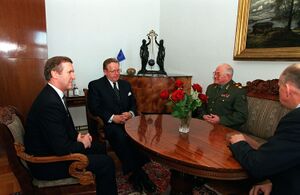
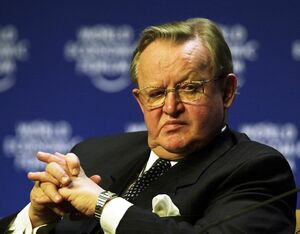
In Finnish politics, Ahtisaari long stressed how important it is for Finland to join NATO.[34] Ahtisaari argued that Finland should be a full member of NATO and the EU in order "to shrug off once and for all the burden of Finlandization".[35] He believed politicians should file application and make Finland a member. He said that the way Finnish politicians avoided expressing their opinion was disturbing.[36] He also noted that the so-called "NATO option" (acquiring membership if Finland were to be threatened) was an illusion, making an analogy to trying to obtain fire insurance when the fire has already started.[37] Finland joined NATO in 2023.[38]
After leaving office, Ahtisaari held positions in various international organisations. In 2000, he became Chairman of the Brussels-based International Crisis Group,[39] an NGO to which he committed $100,000 in government funding in 1994 one month after becoming elected President of Finland.[40] He remained Chairman Emeritus.[41]
Ahtisaari also founded the independent Crisis Management Initiative (CMI) with the goal of developing and sustaining peace in troubled areas. On 1 December 2000, Ahtisaari was awarded the J. William Fulbright Prize for International Understanding by the Fulbright Association in recognition of his work as peacemaker in some of the world's most troubled areas. In May 2017 Ahtisaari suggested as new CMI leader Alexander Stubb a Finnish politician representing Finnish conservatives i.e. the National Coalition Party.[42]
In 2000–01, Ahtisaari and Cyril Ramaphosa inspected IRA weapons dumps for the Independent International Commission on Decommissioning, as part of the Northern Ireland peace process.[43]
In 2003 Ahtisaari defended George W. Bush's attack to Iraq, describing it as humanitarian intervention, which incited criticism from professor of history Juha Sihvola.[44]
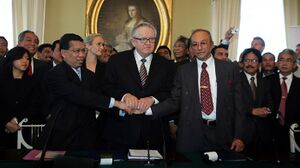
In November 2005, UN Secretary-General Kofi Annan appointed Ahtisaari as Special Envoy for the Kosovo status process which was to determine whether Kosovo, having been administered by the United Nations since 1999, should become independent or remain a province of Serbia. In early 2006, Ahtisaari opened the UN Office of the Special Envoy for Kosovo (UNOSEK) in Vienna, Austria, from where he conducted the Kosovo status negotiations. Those opposed to Ahtisaari's settlement proposal, which involved an internationally monitored independence for Kosovo, sought to discredit him. Allegations made by Balkan media sources of corruption and improper conduct by Ahtisaari were described by US State Department spokesman Tom Casey as "spurious", adding that Ahtisaari's plan is the "best solution possible" and has the "full endorsement of the United States".[45] The New York Times suggested that this criticism of Ahtisaari on the part of the Serbs had led to the "bogging down" of the Kosovo status talks.[46] In November 2008, Serbian media reported Pierre Mirel, director of the EU enlargement commission's western Balkans division as saying: "The EU has accepted that the deployment of EULEX has to be approved by the United Nations Security Council, and that the mission has to be neutral and will not be related to the Ahtisaari plan," Mirel said, following his meeting with Serbia's vice-president Bozidar Djelic.[47]
In July 2007, however, when the EU, Russia and the United States agreed to find a new format for the talks, Ahtisaari announced that he regarded his mission as over. Since neither the UN nor the troika had asked him to continue mediations in the face of Russia's persistent refusal to support independence for Kosovo, he said he would nonetheless be willing to take on "a role as consultant", if requested.[48] After a period of uncertainty and mounting tension, Kosovo unilaterally declared its independence from Serbia in February 2008.[49]
In his work, he emphasised the importance of the United States in the peace process, stating that "There can be no peace without America."[50]
Ahtisaari was chairman of the Interpeace Governing Council from 2000 to 2009.[51][52][53] Beginning in 2009, Ahtisaari was Chairman Emeritus and a Special Advisor.[54]
Ahtisaari was board director of the ImagineNations Group.[55]
That same year he received the 2007 UNESCO Félix Houphouët-Boigny Peace Prize, for "his lifetime contribution to world peace".[56]
In September 2009 Ahtisaari joined The Elders,[57] a group of independent global leaders who work together on peace and human rights issues. He travelled to the Korean Peninsula with fellow Elders Gro Harlem Brundtland, Jimmy Carter and Mary Robinson in April 2011,[58] and to South Sudan with Robinson and Archbishop Desmond Tutu in July 2012.[59]
He was also a member of the board of the European Council on Foreign Relations.[60]
النزاع السوري
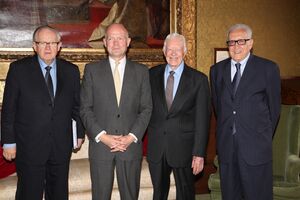
In August 2012, Ahtisaari opined on the sectarian violence in Syria[2] and was mentioned as a possible replacement as Joint Envoy there to succeed former Secretary-General Kofi Annan.[61][62] However, Ahtisaari then told the Finnish state broadcaster YLE that "he wished the mission would fall on someone else"[63] which it ultimately did in the person of Lakhdar Brahimi, a former Algerian foreign minister and longtime U.N. diplomat.[64]
In late 2015, Martti Ahtisaari reiterated charges he already had made in an interview with German broadcaster Deutsche Welle in early 2013 against members of the UN security council on the obstruction of a political solution to the escalating conflict in Syria.[65] Ahtisaari said in an interview in September 2015 that he held talks about Syria with envoys from the five permanent members of the UN security council in February 2012. According to Ahtisaari, Vitaly Churkin, Russian ambassador to the United Nations, laid out three points during a meeting with him, which included not arming the Syrian opposition, commencing talks between Syrian president Assad and the opposition and finding "an elegant way for Assad to step aside". But the US, Britain and France subsequently ignored the proposal. Ahtisaari said in the interview: "Nothing happened because I think all these, and many others, were convinced that Assad would be thrown out of office in a few weeks so there was no need to do anything."[66]
جهوده لإحلال السلام
من أبرز جهود آتيساري التي رشحته لجائزة نوبل للسلام مساعيه في آتشيه و كوسوفا و ناميبيا و أيرلندا الشمالية فضلا عن محاولته التقريب بين الشيعة و السنة في العراق. [67]
وعمل أهتيساري الذي شغل منصب رئيس فنلندا بين عامي 1994 و2000 في السلك الدبلوماسي وخدم بلاده في بلدان عدة امتدت من أفريقيا إلى البلقان ، وكان مرشحا للفوز بالجائزة منذ سنوات.
وقد جاب أهتيساري العالم في خدمة السلام لا سيما بصفته رئيسا لمبادرة إدارة الأزمات وهي منظمة غير حكومية أسسها عام 2000.
وأدت وساطته إلى التوصل إلى اتفاق سلام وقع عام 2005 بين الحكومة الإندونيسية والمعارضة المسلحة المنضوية تحت لواء حركة آتشيه الحرة مما أنهى نزاعا أوقع حوالي 15 ألف قتيل منذ عام 1976.
وبموجب هذا الاتفاق ألقت حركة آتشيه الحرة السلاح كما سحبت السلطة المركزية قسما كبيرا من قواتها المسلحة المنتشرة في الإقليم.
لكن الرئيس الفنلندي السابق لم يتمكن خلال توليه مهام مبعوث الأمم المتحدة الخاص بين نوفمبر 2005 و مارس 2007 من حل أزمة كوسوفو، إذ أعلن هذا الإقليم ذو الأغلبية الألبانية المسلمة استقلاله من جانب واحد عن صربيا في 17 فبراير.
وقد عمل أهتيساري في ناميبيا مبعوثا للأمم المتحدة من أجل تمهيد الأجواء وإعداد البلاد سلميا نحو الاستقلال عن جنوب أفريقيا وهو ما نجح فيه في مارس عام 1990.
وبعد تسع سنوات من اشتغاله بناميبيا عاد ليتولى وساطة أدت إلى وقف ضربات حلف شمال الأطلسي ليوغوسلافيا السابقة في ظل رئاسة الرئيس السابق سلوبودان ميلوفيتش.
وفي عام 2000 أشرف أيضا على نزع أسلحة الجيش الجمهوري الأيرلندي في أيرلندا الشمالية. وفي السنة الماضية نظم محادثات بين عراقيين سنة وآخرين شيعة للتقريب بينهم.
الحياة الشخصية والصحة والوفاة
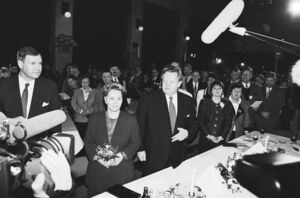
In 1968, he married Eeva Irmeli Hyvärinen,[68] who was studying history at the University of Helsinki and whom he met as a child at the Lyceum in Kuopio. They had one son, Marko Ahtisaari, who was born in 1969.[69]
On 24 March 2020, amid the large-scale outbreak of COVID-19, it was announced that Ahtisaari had tested positive for the disease.[70] His spouse, Eeva Ahtisaari, was diagnosed with the same virus on 21 March. Eeva Ahtisaari had attended the International Women's Day concert on 8 March at the Helsinki Music Centre while infected.[71] On 14 April 2020 it was announced that Martti and Eeva Ahtisaari were recovering from the coronavirus infection.[72]
On 2 September 2021, it was announced that Ahtisaari had Alzheimer's disease and had retired from public life.[73]
Ahtisaari died from complications of Alzheimer's disease in Helsinki, on 16 October 2023, at age 86.[74][75][76] His state funeral was held on 10 November 2023 in Helsinki Cathedral at 1 p.m., after which he was buried at the Hietaniemi Cemetery in Helsinki.[77][78]
. . . . . . . . . . . . . . . . . . . . . . . . . . . . . . . . . . . . . . . . . . . . . . . . . . . . . . . . . . . . . . . . . . . . . . . . . . . . . . . . . . . . . . . . . . . . . . . . . . . . . . . . . . . . . . . . . . . . . . . . . . . . . . . . . . . . . . . . . . . . . . . . . . . . . . . . . . . . . . . . . . . . . . . .
التكريم
جائزة نوبل للسلام
وقد فاز الرئيس الفنلندي السابق مارتي أهتيساري اليوم الجمعة بجائزة نوبل للسلام لدوره في جهود السلام في أماكن عدة من العالم لا سيما ناميبيا التي حصلت على استقلالها عن جنوب أفريقيا عام 1990 وإقليم آتشيه الذي وقع ثواره (حركة آتشيه الحرة) اتفاقا للسلام مع الحكومة الإندونيسية عام 2005.
واختارت لجنة نوبل النرويجية أهتيساري ليحصل على الجائزة وقيمتها 1.4 مليون دولار من بين 197 مرشحا وأعلن رئيس لجنة نوبل النروجية أولي دانبولت ميوس أن أهتيساري (71 عاما) كوفئ "لجهوده الكبرى في عدة قارات على مدى ثلاثة عقود بهدف حل النزاعات الدولية".
وأضاف أن "هذه الجهود ساهمت في وجود عالم أكثر سلما وفي إخاء بين الأمم من وحي مبادئ ألفرد نوبل". ورحب أهتيساري بفوزه بجائزة نوبل للسلام لعام 2008 وقال إنه يعتقد أن أفضل إسهاماته كان في ناميبيا. وقال للإذاعة النرويجية العامة (أناركيه) "بالطبع أنا مسرور جدا بالقرار وممتن للغاية".
وحين سئل عن أهم إنجازاته قال "إن ناميبيا كانت بشكل مطلق الأهم لأنها استغرقت وقتا طويلا لتحقق الاستقلال"، كما أشار إلى عمله في إقليم آتشيه الإندونيسي وفي منطقة البلقان.
On 10 October 2008 Ahtisaari was announced as that year's recipient of the Nobel Peace Prize. Ahtisaari received the prize on 10 December 2008 at Oslo City Hall in Norway.[79] Ahtisaari twice worked to find a solution in Kosovo – first in 1999 and again between 2005 and 2007. He also worked with others this year to find a peaceful solution to the problems in Iraq, the committee said. According to the committee, Ahtisaari and his group, Crisis Management Initiative (CMI), also contributed to resolving other conflicts in Northern Ireland, Central Asia, and the Horn of Africa.[80][81][82] Ahtisaari invited Prime Minister Matti Vanhanen, Foreign Affairs Minister Alexander Stubb and others to his Nobel event, but not President Halonen.[83]
According to the memoir of the former secretary of the Norwegian Nobel Committee, Geir Lundestad, former Foreign Minister and UN ambassador Keijo Korhonen, who was strongly against awarding the 2008 Nobel Peace Prize to Ahtisaari, wrote a letter to the committee which negatively portrayed Ahtisaari as a person and his merits in international conflict zones.[84]
| Coat of Arms of Martti Ahtisaari | |
|---|---|
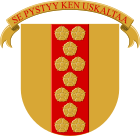 | |
| التفاصيل | |
| Armiger | Martti Ahtisaari |
| Adopted | 1994 |
| Motto | Se pystyy ken uskaltaa ("The one who dares, can") |
التكريم المحلي
 فنلندا:
فنلندا:
 Grand Cross with Collar of the Order of the White Rose of Finland (1999)
Grand Cross with Collar of the Order of the White Rose of Finland (1999) Grand Cross of the Order of the Cross of Liberty
Grand Cross of the Order of the Cross of Liberty Grand Cross of the Order of the Lion of Finland
Grand Cross of the Order of the Lion of Finland Saint Henry Cross
Saint Henry Cross Grand Cross of the Order of the Holy Lamb[85]
Grand Cross of the Order of the Holy Lamb[85]
التكريم الأجنبي
 ألبانيا:
ألبانيا:
 National Flag Decoration (12 September 2016)[86]
National Flag Decoration (12 September 2016)[86]
 أستراليا:
أستراليا:
 Honorary Officer of the Order of Australia (2002)
Honorary Officer of the Order of Australia (2002)
 الأرجنتين:
الأرجنتين:
 Grand Cross with Collar of the Order of the Liberator General San Martín (3 March 1997)[87]
Grand Cross with Collar of the Order of the Liberator General San Martín (3 March 1997)[87]
 بلجيكا:
بلجيكا:
 Grand Cordon of the Order of Leopold
Grand Cordon of the Order of Leopold
 البرازيل:
البرازيل:
 Grand Cross of the Order of the Southern Cross
Grand Cross of the Order of the Southern Cross
 تشيلي:
تشيلي:
 Collar of the Order of Merit
Collar of the Order of Merit
 الدنمارك:
الدنمارك:
 Knight of the Order of the Elephant (1994)
Knight of the Order of the Elephant (1994) Knight of the Order of the Dannebrog[بحاجة لمصدر]
Knight of the Order of the Dannebrog[بحاجة لمصدر]
 إستونيا:
إستونيا:
 Collar of the Order of the Cross of Terra Mariana[88]
Collar of the Order of the Cross of Terra Mariana[88]
 فرنسا:
فرنسا:
 Grand Cross of the Order of Legion of Honour
Grand Cross of the Order of Legion of Honour
 ألمانيا:
ألمانيا:
 Grand Cross Special Class of the Order of Merit of the Federal Republic of Germany
Grand Cross Special Class of the Order of Merit of the Federal Republic of Germany
 اليونان:
اليونان:
 Grand Cross of the Order of the Redeemer
Grand Cross of the Order of the Redeemer
 المجر:
المجر:
 Grand Cross of the Order of Merit of the Republic of Hungary
Grand Cross of the Order of Merit of the Republic of Hungary
 آيسلندا:
آيسلندا:
 Collar with Grand Cross of the Order of the Falcon (26 September 1995)[89]
Collar with Grand Cross of the Order of the Falcon (26 September 1995)[89]
 إندونيسيا:
إندونيسيا:
 Third Class of the Star of the Republic of Indonesia[90]
Third Class of the Star of the Republic of Indonesia[90]
 إيطاليا:
إيطاليا:
 Knight Grand Cross with Collar of the Order of Merit of the Italian Republic (1997)
Knight Grand Cross with Collar of the Order of Merit of the Italian Republic (1997)
 الكويت:
الكويت:
 Grand Cordon of the Order of Mubarak the Great
Grand Cordon of the Order of Mubarak the Great
 لاتڤيا:
لاتڤيا:
 Commander Grand Cross of the Order of the Three Stars:
Commander Grand Cross of the Order of the Three Stars:
 لتوانيا
لتوانيا
 Grand Cross of the Order of Vytautas the Great (1996)[91]
Grand Cross of the Order of Vytautas the Great (1996)[91]
 ماليزيا:
ماليزيا:
 Honorary Recipient of the Most Exalted Order of the Crown of the Realm (1995)[92]
Honorary Recipient of the Most Exalted Order of the Crown of the Realm (1995)[92]
 المكسيك:
المكسيك:
 Collar of the Order of the Aztec Eagle (1999)[93]
Collar of the Order of the Aztec Eagle (1999)[93]
 هولندا:
هولندا:
 Knight Grand Cross of the Order of the Netherlands Lion
Knight Grand Cross of the Order of the Netherlands Lion
 النرويج:
النرويج:
 Grand Cross with Collar of the Order of St. Olav (1994)
Grand Cross with Collar of the Order of St. Olav (1994)
 پولندا:
پولندا:
 Knight of the Order of the White Eagle (1997)[94]
Knight of the Order of the White Eagle (1997)[94]
 رومانيا:
رومانيا:
 Grand Cross of the Order of the Star of Romania
Grand Cross of the Order of the Star of Romania
 جنوب أفريقيا:
جنوب أفريقيا:
 Supreme Companion of the Order of the Companions of O. R. Tambo (16 June 2004)
Supreme Companion of the Order of the Companions of O. R. Tambo (16 June 2004) Grand Cross of the Order of Good Hope (1997)[95]
Grand Cross of the Order of Good Hope (1997)[95]
 إسپانيا:
إسپانيا:
 Knight of the Collar of the Order of Isabella the Catholic[96]
Knight of the Collar of the Order of Isabella the Catholic[96]
 السويد:
السويد:
 Knight with Collar (1996) of the Royal Order of the Seraphim (1994)[97]
Knight with Collar (1996) of the Royal Order of the Seraphim (1994)[97]
 تركيا:
تركيا:
 First Class of the Order of the State of the Republic of Turkey (1999)
First Class of the Order of the State of the Republic of Turkey (1999)
 أوكرانيا:
أوكرانيا:
 First Class of the Order of Yaroslav the Wise
First Class of the Order of Yaroslav the Wise
 الإمارات العربية المتحدة:
الإمارات العربية المتحدة:
 المملكة المتحدة:
المملكة المتحدة:
 Honorary Knight Grand Cross of the Order of the Bath (1995)
Honorary Knight Grand Cross of the Order of the Bath (1995)
الجوائز
- 1995: Zamenhof Prize for International Understanding, of the World Esperanto Association
- 1998: Honorary doctorate from Helsinki University of Technology,[98] and from National University of Kyiv-Mohyla Academy
- 2000: J. William Fulbright Prize for International Understanding[99]
- 2000: Freedom medal[100]
- 2000:
 ألمانيا: Hessian Peace Prize[101][102]
ألمانيا: Hessian Peace Prize[101][102] - 2004: OR Tambo Award[17]
- 2006: Gold Medal of The American-Scandinavian Foundation[103]
- 2007:
 ألمانيا: Manfred Wörner Medal of the German Ministry of Defense[103]
ألمانيا: Manfred Wörner Medal of the German Ministry of Defense[103] - 2007: Honorary degree, University of St. Gallen, Switzerland
- 2008: Delta Prize for Global Understanding[104]
- 2008: Félix Houphouët-Boigny Peace Prize[105]
- 2008: Nobel Peace Prize[106]
- 2008:
 هولندا: Geuzenpenning
هولندا: Geuzenpenning - 2011: Honorary degree, University of Calgary, Canada
انظر أيضاً
المصادر
- ^ "The Nobel Peace Prize 2008". Archived from the original on 12 June 2018. Retrieved 10 October 2008.
- ^ أ ب "Ahtisaari, Tuomioja, Haavisto weigh in on Syria" Archived 17 يونيو 2021 at the Wayback Machine, yle.fi, 3 August 2012. Retrieved 5 August 2012.
- ^ Bryant, Lisa (10 October 2008). "Former Finnish President Martti Ahtisaari Wins Nobel Peace Prize". Voice of America. Archived from the original on 17 November 2008. Retrieved 27 December 2008.
- ^ أ ب ت ث "Martti Ahtisaari". Encyclopedia Britannica. 16 October 2023. Archived from the original on 16 October 2023. Retrieved 21 October 2023.
- ^ Björkqvist, Jeannette (18 June 2017). "Ahtisaari i födelsedagsintervju 2017: Det är inte de mest radikala som har folkets stöd". Hufvudstadsbladet (in السويدية). Archived from the original on 13 August 2023. Retrieved 21 October 2023.
- ^ أ ب ت ث ج ح خ د ذ ر ز س ش ص ض ط ظ ع غ ف ق ك "Ahtisaari, Martti". Suomen kansallisbiografia (The National Biography of Finland) (in الفنلندية). Archived from the original on 21 October 2023. Retrieved 21 October 2023.
- ^ President Ahtisaari's ancestors Archived 3 أبريل 2015 at the Wayback Machine a study by Suomen Sukututkimusseura (the Finnish genealogy society).
- ^ أ ب Heikkinen, Martti (6 August 2011). "Ahtisaari varttui Kuopion kasarmilla". Helsingin Sanomat (in الفنلندية). Archived from the original on 23 August 2021. Retrieved 23 August 2021.
- ^ أ ب ت Tapio, Ilari (16 October 2023). "Valtakuntien sovittelija, presidentti Martti Ahtisaari on poissa". Turun Sanomat (in الفنلندية). Archived from the original on 21 October 2023. Retrieved 23 October 2023.
- ^ "Why AIESEC". AIESEC USC. Archived from the original on 24 October 2023. Retrieved 23 October 2023.
- ^ Heino, Erja-Outi (17 October 2023). "Presidentti Martti Ahtisaari oli myös kehityksen uranuurtaja". Ministry for Foreign Affairs of Finland (in الفنلندية). Archived from the original on 24 October 2023. Retrieved 23 October 2023.
- ^ أ ب ت ث ج ح خ د ذ ر ز س ش "Martti Ahtisaari". Barcelona Centre for International Affairs (in الإسبانية).
- ^ "History of the Embassy of Finland, Dar es Salaam". Embassy of Finland, Dar es Salaam. Archived from the original on 13 August 2016. Retrieved 26 June 2016.
- ^ Shaky start on the road to independence
- ^ Glenys Kinnock (1990). Namibia: Birth of a Nation. Quartet Books Ltd. p. 19.
- ^ "On Resumption: 28th September 2000 – Day 17". Archived from the original on 16 September 2008. Retrieved 22 May 2007.
- ^ أ ب "Outstanding achievement award". Archived from the original on 19 July 2010.
- ^ Sainio, Pentti: Operaatio Ahtisaari. Art House, 1993.
- ^ The Independent On Sunday, 1991 May 19.
- ^ "About Martti Ahtisaari". CMI. Archived from the original on 20 February 2020. Retrieved 18 December 2019.
- ^ Arter, David (1994). "The 1994 Finnish presidential election: Honesty was not the best policy!". West European Politics. 17 (4): 190–192. doi:10.1080/01402389408425049. ISSN 0140-2382.
- ^ Mitä Missä Milloin — Kansalaisen vuosikirja 1995 ("What Where When — Citizen's Yearbook 1995"), Helsinki: Otava Publications Ltd., 1994.
- ^ Anja Snellman and Saska Saarikoski, "The Third Round" / Kolmas kierros, published in Finland in 1994.
- ^ Pertti Sainio, "Secret Operation Ahtisaari" / Operaatio Salainen Ahtisaari, published in Finland in 1993.
- ^ Mitä Missä Milloin — Kansalaisen vuosikirjat 1995, 2000, 2001 ("What Where When — Citizen's Yearbooks 1995, 2000, 2001")
- ^ Veikko Hursti, "For I Was Hungry ..." / Sillä minun oli nälkä ... (autobiography), published in Finland in 1997.
- ^ The speeches are available in electronic form from Finnish Broadcasting Company YLE's Living Archives, "Maaseudulta maailmalle -sarja kertoo vuosien 1956–1966 Suomesta". Archived from the original on 10 February 2015. Retrieved 7 February 2016.
- ^ Helsingin Sanomat, kotimaa, 1998 January 15, p. 1, "Mielenosoitus: Kunniamerkit takaisin Indonesiasta".
- ^ Helsingin Sanomat, Talous, 2000 March 21, p. 3., "Ahtisaari saanee vastaehdokkaan UPM:n hallitus-vaaliin" (tässä jutussa on vain Luontoliiton osuus).
- ^ Mitä Missä Milloin — Kansalaisen vuosikirja 1996 ("What Where When — Citizen's Yearbook 1996"), Helsinki: Otava Publications Ltd., 1995.
- ^ "President would have resigned if Finland had vetoed EU membership". Yle Uutiset. 14 February 2015. Archived from the original on 17 February 2015. Retrieved 14 February 2015.
- ^ Huhta, Kari (22 March 1997). "Huippukokous päättyi yhteisymmärrykseen viidestä turvallisuusjulistuksesta[.] Clinton ja Jeltsin aikovat tiivistää Naton ja Venäjän yhteistyötä[.] Presidentti Clinton lähti illalla kotimatkalle". Helsingin Sanomat (in الفنلندية). Archived from the original on 23 August 2021. Retrieved 23 August 2021.
- ^ Huhta, Kari (20 May 1999). "Tshernomyrdin yksin Helsingistä Belgradiin". Helsingin Sanomat (in الفنلندية). p. C1. Archived from the original on 23 August 2021. Retrieved 23 August 2021.
- ^ Martti Ahtisaari Wants Finland in Nato Archived 29 فبراير 2012 at the Wayback Machine. YLE. 11 October 2008
- ^ "Former President Ahtisaari: NATO membership would put an end to Finlandisation murmurs". Helsingin Sanomat. 15 December 2003. Archived from the original on 5 December 2008. Retrieved 20 September 2008.
- ^ Ahtisaari NATO-kansanäänestystä vastaan Archived 23 يوليو 2009 at the Wayback Machine. MTV3
- ^ "Presidentti Martti Ahtisaari 23.11.2007: Nato-optio on illuusio". Archived from the original on 4 August 2012.
- ^ "Finland joins NATO as 31st Ally". nato.int. Archived from the original on 4 April 2023. Retrieved 5 April 2023.
- ^ Barbara Crossette (1 December 2008). "Peace Prize Comes With Criticism". The Nation. Archived from the original on 6 April 2019. Retrieved 5 April 2019.
After his term as president of Finland ended in 2000, Ahtisaari became board chairman of the International Crisis Group, an independent analysis and advocacy organization based in Brussels.
- ^ Stephen Solarz (2010). "Transforming an Idea into Reality". 1995–2010 Fifteen Years on the Front Lines – International Crisis Group. ICG. p. 12. Archived from the original on 7 March 2013.
Martti Ahtisaari, had just been elected President of Finland a month earlier. When I explained to Martti what we had in mind, he immediately and graciously offered to provide $100,000 in funding from Finland
- ^ "Board of Trustees". International Crisis Group. ICG. 22 July 2016. Archived from the original on 5 April 2019. Retrieved 5 April 2019.
Chairmen Emeriti – Martti Ahtisaari
- ^ Ahtisaari luopuu perustamansa CMI-järjestön puheenjohtajuudesta – ehdottaa seuraajakseen Alexander Stubbia Archived 9 مايو 2017 at the Wayback Machine YLE 9 May 2017
- ^ "Reports of the Weapons Inspectors". Reports and Statements by the Independent International Commission on Decommissioning (IICD). CAIN. Archived from the original on 6 December 2010. Retrieved 11 October 2008.
- ^ "Oikeutettu Sota?". Vihreä Lanka (in الفنلندية). 2003. Archived from the original on 10 May 2015. Retrieved 28 October 2015.
- ^ Department Of State. The Office of Electronic Information, Bureau of Public Affairs (13 July 2007). "Daily Press Briefing – July 13". 2001-2009.state.gov. Archived from the original on 3 August 2020. Retrieved 25 May 2019.
- ^ The New York Times – Serbs Criticize UN Mediator, Further Bogging Down Kosovo Talks Archived 4 يناير 2016 at the Wayback Machine.
- ^ "EU accepts Belgrade's conditions for EULEX". The Sofia Echo. 7 November 2008. Archived from the original on 12 January 2009. Retrieved 7 November 2008.
- ^ "Contact Group Meets on Kosovo′s Future as Tensions Rise – Europe – DW.COM – 25.07.2007". DW.COM. Archived from the original on 18 February 2008. Retrieved 23 August 2007.
- ^ "US Pleased With Post-Independence Progress in Kosovo". Archived from the original on 3 August 2008.
- ^ Cord, David J. (2012). Mohamed 2.0. Helsingfors: Schildts & Söderströms. p. 156. ISBN 978-951-52-2898-7.
- ^ John A. Kufuor Foundation "Interpeace" Archived 28 ديسمبر 2011 at the Wayback Machine Retrieved on 27 January 2012
- ^ IDRC "IDRC Partner Awarded Nobel Peace Prize" Retrieved on 3 February 2012
- ^ Imagine Nations "Martti Ahtisaari" Archived 5 مارس 2012 at the Wayback Machine Retrieved on 3 February 2012
- ^ Interpeace "Governing Council" Archived 1 أبريل 2015 at the Wayback Machine Retrieved on 27 January 2012
- ^ "President Martti Ahtisaari | Leadership Team". ImagineNations Group. Archived from the original on 23 August 2021. Retrieved 23 August 2021.
- ^ "Valtioneuvosto – Ahtisaari received the UNESCO Peace Prize". Archived from the original on 10 June 2011.
- ^ "Martti Ahtisaari joins The Elders". TheElders.org. 21 September 2009. Archived from the original on 24 August 2018. Retrieved 6 March 2013.
- ^ "Carter, 3 other ex-leaders to push for renewed Koreas talks". CNN.com. 27 April 2011. Archived from the original on 6 May 2011. Retrieved 6 March 2013.
- ^ "The Elders visit South Sudan in sombre mood and urge continued dialogue with Khartoum". TheElders.org. 6 July 2012. Archived from the original on 18 November 2018. Retrieved 6 March 2013.
- ^ "European Council on Foreign Relations". Archived from the original on 14 March 2015. Retrieved 19 September 2010.
- ^ "General Assembly adopts Resolution on Syria", transcript of UK Ambassador Sir Mark Lyall Grant's remarks at the 'stakeout' after adoption of the resolution, British UN Mission website, 3 August 2012. Ahtisaari's name only mentioned in a media question. No comment from Grant. Retrieved 3 August 2012.
- ^ "'Crazy' Enough to Take on Syria?" Archived 11 يونيو 2015 at the Wayback Machine, The New York Times, 3 August 2012. Posted 3 August 2012.
- ^ "Ahtisaari Syyria-tehtävästä: Toivoisin, että se menisi jonnekin muualle". YLE Uutiset (in الفنلندية). 8 August 2012. Archived from the original on 9 August 2012. Retrieved 11 August 2012.
- ^ "UN: Algeria's Brahimi will replace Annan in Syria", AP via New York Daily News, 17 August 2012. Retrieved 23 August 2012.
- ^ Ahtisaari: "Sicherheitsrat ist schuld" Archived 19 أبريل 2016 at the Wayback Machine, dw.com, 11 February 2013 (in German)
- ^ West 'ignored Russian offer in 2012 to have Syria's Assad step aside' Archived 8 أكتوبر 2016 at the Wayback Machine, theguardian.com, 15 September 2015
- ^ الجزيرة نت
- ^ "Eeva Ahtisaari". Archived from the original on 21 October 2023. Retrieved 10 October 2008.
- ^ Merikallio, Katri (16 October 2023). "Martti Ahtisaarelle rauha oli tahdon asia". Suomen Kuvalehti (in الفنلندية). Archived from the original on 24 October 2023. Retrieved 23 October 2023.
- ^ "Former President Martti Ahtisaari tests positive for coronavirus". Yle News. 24 March 2020. Archived from the original on 25 March 2020. Retrieved 24 March 2020.
- ^ von Kraemer, Maria (21 March 2020). "Eeva Ahtisaari har smittats av coronaviruset" (in السويدية). Yle Svenska. Archived from the original on 22 March 2020. Retrieved 24 March 2020.
- ^ Uusitalo, Kaisa: Presidenttipari parantumassa koronaviruksesta – Martti ja Eeva Ahtisaaren uusimmat koronavirusnäytteet negatiivisia Archived 14 أبريل 2020 at the Wayback Machine, YLE 14 April 2020. Accessed on 16 April 2020.
- ^ "Former President Ahtisaari retires from public life following Alzheimer's diagnosis". Yle News. 2 September 2021. Archived from the original on 2 September 2021. Retrieved 2 September 2021.
- ^ Anne Kauranen (16 October 2023). "Finnish Nobel Peace laureate and former president Ahtisaari dies at 86". Reuters. Archived from the original on 16 October 2023. Retrieved 16 October 2023.
- ^ Cowell, Alan (16 October 2023). "Martti Ahtisaari, Finnish Nobel Peace Prize Winner, Dies at 86". The New York Times. Archived from the original on 16 October 2023. Retrieved 16 October 2023.
- ^ "Martti Ahtisaari obituary". The Times. 18 October 2023. Archived from the original on 19 October 2023. Retrieved 18 October 2023.
- ^ "State funeral of President Martti Ahtisaari to be held in Helsinki on St Martin's Day, 10 November". Finnish Government. 18 October 2023. Archived from the original on 18 October 2023. Retrieved 18 October 2023.
- ^ Hyttinen, Tuomas (18 October 2023). "Presidentti Ahtisaaren valtiolliset hautajaiset pidetään Martin päivänä 10. marraskuuta". Yle (in الفنلندية). Archived from the original on 18 October 2023. Retrieved 18 October 2023.
- ^ "The Nobel Peace Prize Award Ceremony 2008". NobelPrize.org (in الإنجليزية الأمريكية). Archived from the original on 26 October 2023. Retrieved 24 October 2023.
- ^ "Ahtisaari finally wins his own Nobel Peace Prize". Aftenposten. 10 October 2008. Archived from the original on 13 October 2008. Retrieved 13 October 2008.
- ^ "Nobel Peace Prize goes to peace broker Ahtisaari". Aftenposten. 10 October 2008. Archived from the original on 10 October 2008. Retrieved 13 October 2008.
- ^ "The Nobel Peace Prize 2008 awarded to Martti Ahtisaari". The Norway Post. Norwegian Broadcasting Corporation/TNC. 10 October 2008. Retrieved 13 October 2008.[dead link]
- ^ Presidentti Halosta ei kutsuttu Ahtisaaren Nobel-juhliin Archived 20 أكتوبر 2012 at the Wayback Machine. Helsingin Sanomat
- ^ "Norjalaiskirja paljastaa: Keijo Korhonen yritti estää Martti Ahtisaaren Nobel-palkinnon". Verkkouutiset. 18 September 2015. Archived from the original on 20 September 2015. Retrieved 18 September 2015.
- ^ "Pyhän Karitsan suurristi Ahtisaarelle". Helsingin Sanomat (in الفنلندية). 22 February 1995. p. A 4. Archived from the original on 17 May 2023. Retrieved 17 May 2023.
- ^ "Dekorata e flamurit kombëtar". Presidenti i Republikës së Shqipërisë (in الإنجليزية الأمريكية). Archived from the original on 11 November 2020. Retrieved 11 November 2020.
- ^ "Menem recibió al primer mandatario de Finlandia". LA NACION (in الإسبانية). 4 March 1997. Archived from the original on 16 October 2023. Retrieved 16 October 2023.
- ^ Estonian Presidency Website (Estonian), Estonian State Decorations, Martti Ahtisaari Archived 6 يونيو 2013 at the Wayback Machine – Eeva Ahtisaari Archived 6 يونيو 2013 at the Wayback Machine
- ^ Icelandic Presidency Website (Icelandic), Order of the Falcon, Martti & Eeva Ahtisaari Archived 13 مارس 2016 at the Wayback Machine, 26 September 1995, Grand Cross with Collar & Grand Cross respectively
- ^ "Presiden Anugerahkan Bintang Utama Kepada Ahtisaari". Archived from the original on 4 April 2015.
- ^ "Apdovanotų asmenų duomenų bazė". Lietuvos Respublikos Prezidento kanceliarija (in الليتوانية). Retrieved 16 October 2023.
- ^ "Bahagian Istiadat dan Urusetia Persidangan Antarabangsa". istiadat.gov.my. Archived from the original on 19 July 2019. Retrieved 15 June 2016.
- ^ "ACUERDO por el que se otorga al excelentísimo señor Martti Ahtisaari, la Condecoración Orden Mexicana del Aguila Azteca, en grado de Gran Collar". Diario Oficial de la Federación (in الإسبانية). Archived from the original on 16 October 2023. Retrieved 16 October 2023.
- ^ "Pokojowy Nobel dla mistrza mediacji". Rzeczpospolita (in البولندية). Archived from the original on 16 October 2023. Retrieved 16 October 2023.
- ^ "1997 National Orders awards". Archived from the original on 15 October 2012.
- ^ "BOE-A-1999-2504 Real Decreto 174/1999, de 29 de enero, por el que se concede el Collar de la Orden de Isabel la Católica a su excelencia señor Martti Ahtisaari, Presidente de la República de Finlandia". BOE. Archived from the original on 17 October 2023. Retrieved 16 October 2023.
- ^ "Archived copy". Archived from the original on 12 November 2013. Retrieved 2 October 2012.
{{cite web}}: CS1 maint: archived copy as title (link) - ^ "TKK Honorary Doctor Martti Ahtisaari to receive Nobel Peace Prize"[dead link], Aalto University webpage, 13 October 2008. AU is successor to HUT/TKK. Retrieved 8 August 2012.
- ^ "Martti Ahtisaari" (PDF). Archived (PDF) from the original on 21 October 2023. Retrieved 23 October 2023.
- ^ Four Freedoms Award#Freedom Medal
- ^ Laureates of the Hessian Peace Prize Archived 17 فبراير 2016 at the Wayback Machine, hsfk.de
- ^ Dead link at Crisis Management Initiative website: "CMI – Martti Ahtisaari Peace Foundation". Archived from the original on 9 May 2013. Retrieved 10 October 2008..
- ^ أ ب CV of Martti Ahtisaari Archived 7 مارس 2016 at the Wayback Machine, cmi.fi
- ^ "The Delta Prize for Global Understanding". Archived from the original on 24 October 2023. Retrieved 23 October 2023.
- ^ "Award ceremony of the Félix Houphouët-Boigny Peace Prize, UNESCO, 2 October 2008: address by Mr Martti Ahtisaari, Former President of the Republic of Finland, 2007 Prizewinner". Archived from the original on 24 October 2023. Retrieved 23 October 2023.
- ^ "The Nobel Peace Prize 2008". NobelPrize.org. Archived from the original on 3 September 2023. Retrieved 23 October 2023.
وصلات خارجية
- Martti Ahtisaari's Project Syndicate op/eds
- {{Nobelprize}} template missing ID and not present in Wikidata.
- Ahtisaari Nobel Prize lecture
- ThisisFINLAND -Nobel recognition rewards peaceful resolutions
- Appearances on C-SPAN
- Martti Ahtisaari in The Presidents of Finland
| مناصب سياسية | ||
|---|---|---|
| سبقه Mauno Koivisto |
President of Finland 1994–2000 |
تبعه تاريا هالونن |
| جوائز وانجازات | ||
| سبقه Al Gore Intergovernmental Panel on Climate Change |
Laureate of the Nobel Peace Prize 2008 |
تبعه باراك أوباما |
- CS1 السويدية-language sources (sv)
- CS1 الفنلندية-language sources (fi)
- CS1 الإسبانية-language sources (es)
- CS1 الإنجليزية الأمريكية-language sources (en-us)
- Articles with dead external links from September 2010
- CS1 الليتوانية-language sources (lt)
- CS1 البولندية-language sources (pl)
- Articles with dead external links from November 2016
- Short description with empty Wikidata description
- مواليد 23 يونيو
- مواليد 1937
- سنة الميلاد مختلفة في ويكي بيانات
- شهر الميلاد مختلف في ويكي بيانات
- يوم الميلاد مختلف في ويكي بيانات
- Pages using infobox officeholder with unknown parameters
- Articles with hatnote templates targeting a nonexistent page
- مقالات ذات عبارات بحاجة لمصادر
- مارتي آتيساري
- وفيات 2023
- رؤساء فنلندا
- سياسيون فنلنديون
- دبلوماسيون فنلنديون
- فنلديون حائزون على جائزة نوبل
- فرسان الفيل
- ديمقراطيون إشتراكيون
- حائزو جائزة نوبل للسلام
- University of Oulu alumni
- Finnish schoolteachers
- YMCA leaders
- Finnish people of Norwegian descent
- Finnish Lutherans
- Politicians from Vyborg
- Deaths from Alzheimer's disease
- Knights Grand Cross of the Order of the Falcon
- Knights of the Order of the Dannebrog
- Recipients of the Collar of the Order of the Cross of Terra Mariana
- Grand Crosses of the Order of Vytautas the Great
- Knights Grand Cross of the Order of Merit of the Italian Republic
- Honorary Knights Grand Cross of the Order of the Bath
- Collars of the Order of Isabella the Catholic
- Recipients of the Order of Prince Yaroslav the Wise, 1st class
- Under-Secretaries-General of the United Nations
- Ambassadors of Finland to Somalia
- Ambassadors of Finland to Zambia
- Ambassadors of Finland to Mozambique
- Ambassadors of Finland to Ethiopia
- Ambassadors of Finland to Tanzania
- Candidates for President of Finland
- Finnish expatriates in Pakistan
- Finnish expatriates in Namibia
- Grand Crosses of the Order of the Star of Romania
- Special Representatives of the Secretary-General of the United Nations
- Special Envoys of the Secretary-General of the United Nations
- Diplomats from Vyborg
- 20th-century Finnish diplomats
